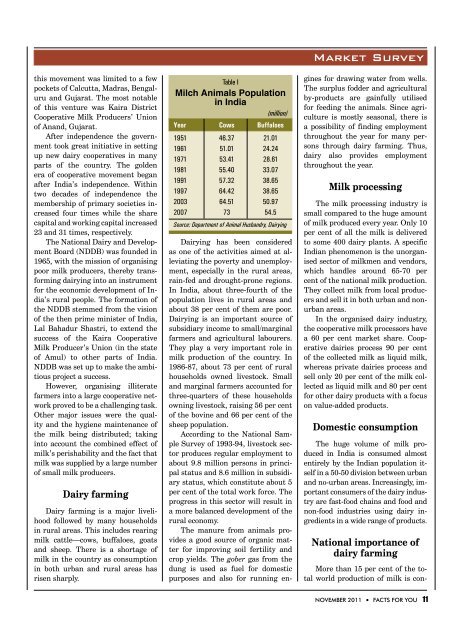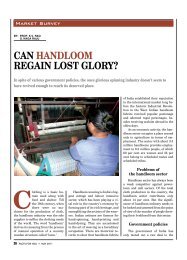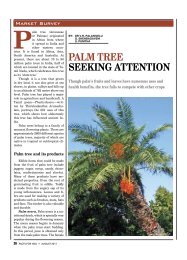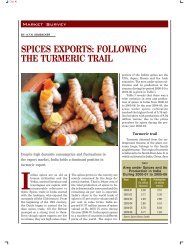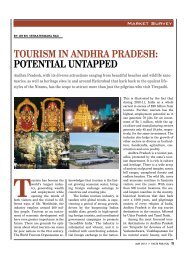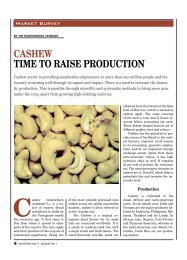DaIry farmIng the rural cash cow - Facts For You
DaIry farmIng the rural cash cow - Facts For You
DaIry farmIng the rural cash cow - Facts For You
Create successful ePaper yourself
Turn your PDF publications into a flip-book with our unique Google optimized e-Paper software.
this movement was limited to a few<br />
pockets of Calcutta, Madras, Bengaluru<br />
and Gujarat. The most notable<br />
of this venture was Kaira District<br />
Cooperative Milk Producers’ Union<br />
of Anand, Gujarat.<br />
After independence <strong>the</strong> government<br />
took great initiative in setting<br />
up new dairy cooperatives in many<br />
parts of <strong>the</strong> country. The golden<br />
era of cooperative movement began<br />
after India’s independence. Within<br />
two decades of independence <strong>the</strong><br />
membership of primary societies increased<br />
four times while <strong>the</strong> share<br />
capital and working capital increased<br />
23 and 31 times, respectively.<br />
The National Dairy and Development<br />
Board (NDDB) was founded in<br />
1965, with <strong>the</strong> mission of organising<br />
poor milk producers, <strong>the</strong>reby transforming<br />
dairying into an instrument<br />
for <strong>the</strong> economic development of India’s<br />
<strong>rural</strong> people. The formation of<br />
<strong>the</strong> NDDB stemmed from <strong>the</strong> vision<br />
of <strong>the</strong> <strong>the</strong>n prime minister of India,<br />
Lal Bahadur Shastri, to extend <strong>the</strong><br />
success of <strong>the</strong> Kaira Cooperative<br />
Milk Producer’s Union (in <strong>the</strong> state<br />
of Amul) to o<strong>the</strong>r parts of India.<br />
NDDB was set up to make <strong>the</strong> ambitious<br />
project a success.<br />
However, organising illiterate<br />
farmers into a large cooperative network<br />
proved to be a challenging task.<br />
O<strong>the</strong>r major issues were <strong>the</strong> quality<br />
and <strong>the</strong> hygiene maintenance of<br />
<strong>the</strong> milk being distributed; taking<br />
into account <strong>the</strong> combined effect of<br />
milk’s perishability and <strong>the</strong> fact that<br />
milk was supplied by a large number<br />
of small milk producers.<br />
Dairy farming<br />
Dairy farming is a major livelihood<br />
followed by many households<br />
in <strong>rural</strong> areas. This includes rearing<br />
milk cattle—<strong>cow</strong>s, buffaloes, goats<br />
and sheep. There is a shortage of<br />
milk in <strong>the</strong> country as consumption<br />
in both urban and <strong>rural</strong> areas has<br />
risen sharply.<br />
Table I<br />
Milch Animals Population<br />
in India<br />
(million)<br />
Year Cows Buffaloes<br />
1951 46.37 21.01<br />
1961 51.01 24.24<br />
1971 53.41 28.61<br />
1981 55.40 33.07<br />
1991 57.32 38.65<br />
1997 64.42 38.65<br />
2003 64.51 50.97<br />
2007 73 54.5<br />
Source: Department of Animal Husbandry, Dairying<br />
Market Survey<br />
Dairying has been considered<br />
as one of <strong>the</strong> activities aimed at alleviating<br />
<strong>the</strong> poverty and unemployment,<br />
especially in <strong>the</strong> <strong>rural</strong> areas,<br />
rain-fed and drought-prone regions.<br />
In India, about three-fourth of <strong>the</strong><br />
population lives in <strong>rural</strong> areas and<br />
about 38 per cent of <strong>the</strong>m are poor.<br />
Dairying is an important source of<br />
subsidiary income to small/marginal<br />
farmers and agricultural labourers.<br />
They play a very important role in<br />
milk production of <strong>the</strong> country. In<br />
1986-87, about 73 per cent of <strong>rural</strong><br />
households owned livestock. Small<br />
and marginal farmers accounted for<br />
three-quarters of <strong>the</strong>se households<br />
owning livestock, raising 56 per cent<br />
of <strong>the</strong> bovine and 66 per cent of <strong>the</strong><br />
sheep population.<br />
According to <strong>the</strong> National Sample<br />
Survey of 1993-94, livestock sector<br />
produces regular employment to<br />
about 9.8 million persons in principal<br />
status and 8.6 million in subsidiary<br />
status, which constitute about 5<br />
per cent of <strong>the</strong> total work force. The<br />
progress in this sector will result in<br />
a more balanced development of <strong>the</strong><br />
<strong>rural</strong> economy.<br />
The manure from animals provides<br />
a good source of organic matter<br />
for improving soil fertility and<br />
crop yields. The gober gas from <strong>the</strong><br />
dung is used as fuel for domestic<br />
purposes and also for running engines<br />
for drawing water from wells.<br />
The surplus fodder and agricultural<br />
by-products are gainfully utilised<br />
for feeding <strong>the</strong> animals. Since agriculture<br />
is mostly seasonal, <strong>the</strong>re is<br />
a possibility of finding employment<br />
throughout <strong>the</strong> year for many persons<br />
through dairy farming. Thus,<br />
dairy also provides employment<br />
throughout <strong>the</strong> year.<br />
Milk processing<br />
The milk processing industry is<br />
small compared to <strong>the</strong> huge amount<br />
of milk produced every year. Only 10<br />
per cent of all <strong>the</strong> milk is delivered<br />
to some 400 dairy plants. A specific<br />
Indian phenomenon is <strong>the</strong> unorganised<br />
sector of milkmen and vendors,<br />
which handles around 65-70 per<br />
cent of <strong>the</strong> national milk production.<br />
They collect milk from local producers<br />
and sell it in both urban and nonurban<br />
areas.<br />
In <strong>the</strong> organised dairy industry,<br />
<strong>the</strong> cooperative milk processors have<br />
a 60 per cent market share. Cooperative<br />
dairies process 90 per cent<br />
of <strong>the</strong> collected milk as liquid milk,<br />
whereas private dairies process and<br />
sell only 20 per cent of <strong>the</strong> milk collected<br />
as liquid milk and 80 per cent<br />
for o<strong>the</strong>r dairy products with a focus<br />
on value-added products.<br />
Domestic consumption<br />
The huge volume of milk produced<br />
in India is consumed almost<br />
entirely by <strong>the</strong> Indian population itself<br />
in a 50-50 division between urban<br />
and no-urban areas. Increasingly, important<br />
consumers of <strong>the</strong> dairy industry<br />
are fast-food chains and food and<br />
non-food industries using dairy ingredients<br />
in a wide range of products.<br />
National importance of<br />
dairy farming<br />
More than 15 per cent of <strong>the</strong> total<br />
world production of milk is con-<br />
November 2011 • FACTS FOR YOU 11


